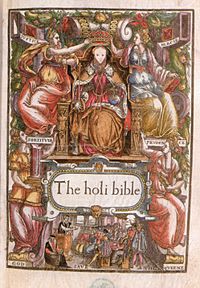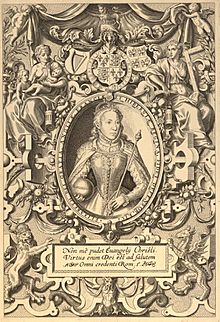Bishops' Bible facts for kids
Quick facts for kids Bishops' Bible |
|
|---|---|
 |
|
| Full name: | {{{full_name}}} |
| Complete Bible published: | 1568 |
| Translation type: | Formal Equivalence |
The Bishops' Bible is an English version of the Bible. It was created in 1568 by the Church of England. This Bible was an important step in making the Bible available in English. It was later used as the main text for the famous King James Version in 1611.
Contents
Why the Bishops' Bible Was Made
The Bishops' Bible came after two other important English Bibles. These were the Great Bible from 1539 and the Geneva Bible from 1560. The Great Bible was the first English Bible officially allowed for church use.
The Geneva Bible was very popular, especially for reading at home. However, some of its notes and ideas did not please the leaders of the Church of England. These leaders, mostly bishops, wanted a new Bible version. They also knew the Great Bible needed updates. Much of its Old Testament was translated from Latin, not the original Hebrew and Greek. So, they decided to create their own version, which became known as the "Bishops' Bible."
Who Created the Bishops' Bible?
The main person behind this project was Matthew Parker. He was the Archbishop of Canterbury, a very important leader in the Church of England. Archbishop Parker asked different bishops to translate different parts of the Bible. To make sure they worked hard, their initials were put at the end of the sections they translated. For example, "W.E." at the end of Deuteronomy stood for William Alley, the Bishop of Exeter.
Archbishop Parker was very busy. He couldn't check all the work himself. Because of this, the way the Bible was translated varied a lot from one book to another. For instance, in most of the Old Testament, the name of God, YHWH, was translated as "the LORD." But in the Psalms, it was translated differently. Some parts were very similar to the Great Bible, while others were closer to the Geneva Bible.

The parts of the Bible known as the Apocrypha were mostly copied from the Great Bible. This meant they were still based on the Latin version, not the original languages. So, the Bishops' Bible wasn't entirely translated from the original Hebrew, Aramaic, and Greek.
Changes and Purpose
The Bishops' Bible was first published in 1568. It was then updated in 1572. In this update, some words in the New Testament were changed to sound more "church-like." For example, "charity" was used instead of "love" in some places. The Psalms were also changed because the new translation was hard to sing in church.
This Bible had the king's official approval. It was the second Bible allowed to be read aloud in church services. However, it was not meant to be a Bible for people to read at home. Its main purpose was to be a "pulpit Bible," meaning it was for use by priests in church. It was grander than the Geneva Bible. The first edition was very large and had 124 full-page pictures. Later editions were smaller and had fewer illustrations.
The Bishops' Bible did not have many notes or cross-references like the Geneva Bible. The Geneva Bible's notes often contained ideas that were debated, but they were helpful for people who were just starting to read the Bible in English. The last full edition of the Bishops' Bible came out in 1602. Even though it was important, the Geneva Bible was reprinted much more often.
Its Lasting Impact
The translators of the famous King James Version (published in 1611) were told to use the 1602 edition of the Bishops' Bible as their starting point. After the King James Version came out, it quickly took the Bishops' Bible's place in the Church of England.
Some people later said the Bishops' Bible wasn't very good. They felt that the parts copied from the Geneva Bible were fine, but the new translations were not as strong. However, it was still a very important step. It helped English people move from a time when reading the Bible was forbidden to a time when they could read it easily. The people who revised it worked hard to give God's book to God's people in a language they could understand. The King James translators built on this good work to make it even better.
The Bishops' Bible is not often reprinted today. However, you can find copies that look exactly like the originals. One interesting fact is that the Bishops' Bible is sometimes called the "Treacle Bible." This is because of its translation of Jeremiah 8:22. It reads: "Is there not treacle at Gilead?" "Treacle" means a sweet syrup. In the King James Version, this word was changed to "balm," referring to the Balm of Gilead.
| The Bible in English |
| Old English (pre-1066) |
| Middle English (1066-1500) |
| Early Modern English (1500-1800) |
| Modern Christian (1800-) |
| Modern Jewish (1853-) |
| Miscellaneous |
See also
- Matthew Bible
- Great Bible
- Geneva Bible

